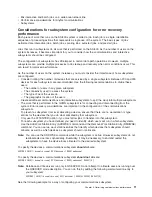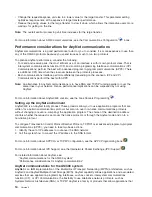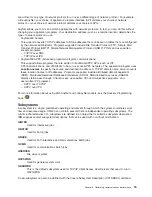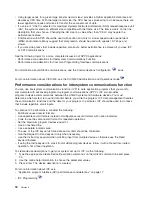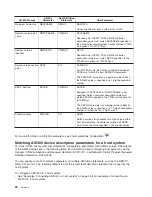
AS/400 Prompt
AS/400
Parameter
Host Definition
Statement
Host Parameter
Maximum frame size
MAXFRAME
GROUP
MAXDATA
Values specified for each system must match.
Remote control point
name
RMTCPNAME
VTAMLST
SSCPNAME
Required only if APPN(*YES). AS/400 controller
description value must match SSCPNAME specified in
the Virtual Telecommunications Access Method (VTAM)
start options list (ATCSTR
yy
).
Remote network
identifier
RMTNETID
VTAMLST
NETID
Required only if APPN(*YES). AS/400 controller
description value must match NETID specified in the
VTAM start options list (ATCSTR
yy
).
Source service access
point
SSAP
PU
SAPADDR
For 9370/LAN only, the AS/400 controller description
DSAP must match the host SAPADDR parameter.
The SAPADDR parameter is a decimal value (4-252);
the AS/400 value is specified as a 2-digit hexadecimal
number.
SSCP identifier
SSCPID
VTAMLST
SSCPID
Required if APPN(*YES) or if RMTCPNAME is not
specified. AS/400 controller description value must
match SSCPID specified in the VTAM start options list
(ATCSTR
yy
).
The SSCPID parameter is a decimal value (0-65535);
the AS/400 value is specified as a 12-digit hexadecimal
number, of which the first 2 digits are
05
.
Station address
STNADR
PU
ADDR
AS/400 system station address must be unique within
host PU definitions. Controller description STNADR
must match the value specified in the line description.
For more information on AS/400 parameters, see Communications Configuration
.
Matching AS/400 device description parameters for a host system
You must match host system communications configuration parameters with AS/400 values. A description
of the AS/400 values are in the following table. For information about configuring host systems, see the
manuals
VTAM Installation and Resource Definition
, SC23-0111, and
Network Control Program Resource
Definition Reference
, SC30-3254.
You can specify some host system parameters on multiple definition statements, such as the GROUP,
LINE, PU, and LU. The following table lists only the lowest level definition statement that is used by the
host system.
To configure an AS/400 to a host system:
v
See “Examples: Connecting AS/400 to a host system” on page 26 for an example of connecting an
AS/400 to a host system.
24
Version 5
Summary of Contents for AS/400
Page 1: ...iSeries Networking iSeries Communications Management ERserver...
Page 2: ......
Page 3: ...iSeries Networking iSeries Communications Management ERserver...
Page 8: ...2 Version 5...
Page 10: ...4 Version 5...
Page 12: ...6 Version 5...
Page 22: ...For more information about creating subsystems see the Work Management book 16 Version 5...
Page 26: ...20 Version 5...
Page 34: ...Example 3 AS 400 system for DLUR support with the host system 28 Version 5...
Page 36: ...30 Version 5...
Page 46: ...40 Version 5...
Page 57: ...Chapter 7 Communicating with remote workstation controllers 51...
Page 63: ...Chapter 7 Communicating with remote workstation controllers 57...
Page 82: ...Example 2 AS 400 to 4690 PEER connection over token ring network 76 Version 5...
Page 83: ...Chapter 7 Communicating with remote workstation controllers 77...
Page 84: ...78 Version 5...
Page 102: ...96 Version 5...
Page 103: ......
Page 104: ...Printed in U S A...


